

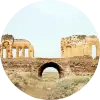

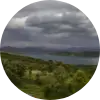


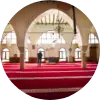


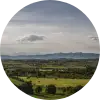



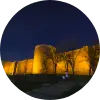
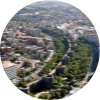

Dağ Kapı, also known as Harput Kapı, is one of the four main gates of the Diyarbakır city walls and is a historically significant structure. Here are some basic facts about Dağ Kapı:
Location and Structure: Dağ Kapı is located north of the Diyarbakır city walls. It is positioned between two cylindrical towers, providing a passage that connects these two towers.
History: It is known that both towers were initially built by the Roman Emperor Constantine II but underwent various repairs and renovations over time. This is evident from the inscriptions found on the gate. Dağ Kapı hosts inscriptions in Latin and Greek from the Roman and Byzantine periods, as well as inscriptions from the Abbasid and Marwanid periods.
Architectural Elements: Dağ Kapı is a two-story tower structure. On the second floor, there is a mosque dating back to the Marwanid period. This is an important feature indicating that the gate has been influenced by different civilizations over time.
Condition and Use: Unfortunately, Dağ Kapı is currently in a ruined state. However, the Dağ Kapı Tower is used as the State Art Gallery today, serving as a platform for art and cultural events.
Inscriptions and Monuments: Dağ Kapı carries historical traces of different periods through the inscriptions found on it. Efforts by various civilizations to repair or use this gate from the Roman and Byzantine periods onwards are documented in the inscriptions found on the structure.
Dağ Kapı is an important structure reflecting the historical and cultural richness of Diyarbakır as part of the historical city walls. Today, the Dağ Kapı Tower, serving as the State Art Gallery, offers visitors a historical experience.